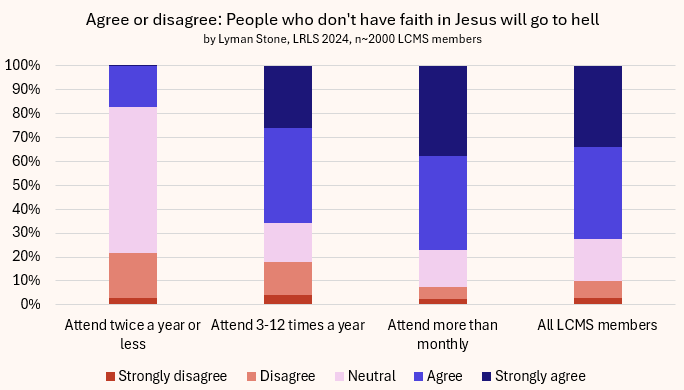Are Lutherans Growing? Shrinking? Liberal? Conservative? Three Surveys Disagree
Evidence from the Pew Religious Landscape Survey, the Lutheran Religious Life Survey, and the Cooperative Congressional Election Study
Recently, Pew Research published their 2023-2024 Religious Landscape Study, a large, landmark study of religious life in America (35,000 respondents, online and in-person). Pew’s religion surveys are widely regarded as a gold standard.
I’m not going to review their headline findings. This is a post exclusively for my LCMS family. I’m a member of the Lutheran Church-Missouri Synod (LCMS), and I do surveys of LCMS members. As such, Pew’s results were interesting to me. Here, I’m going to analyze them, as well as two other surveys. The three surveys I will analyze are:
Pew Religious Landscape Study- Conducted in 2007, 2014, and 2023-24, the PRLS has surveyed approximately 1800 LCMS/WELS (Wisconsin Evangelical Lutheran Synod) members across those three surveys. I merge LCMS/WELS to capture the broader spectrum of conservative Lutheranism, and because in some surveys the groups are imprecisely separated. In the 2023-24 round, we do not know the exact sample, but probably Pew sampled between 400 and 650 people who claimed to be LCMS or WELS.
Cooperative Congressional Election Survey- Conducted in almost every year 2006-2023, the CCES has surveyed over 23,000 LCMS/WELS self-identified members across those years. Merging the years 2018-2023, it has sampled 3,750 LCMS members and 755 WELS members.
Lutheran Religious Life Survey- Conducted in an overlapping sample 2021-2024, the LRLS is conducted within Lutheran communities, and so has much higher reliability in terms of avoiding erroneous LCMS-self-identification. In the 2024 wave, about 2,000 LCMS members were surveyed. The LRLS is weighted to match baseline population demographics of LCMS members reported in the CCES.
What I’m going to show you is that the recently-released Pew Religious Landscape Study is probably an incorrect assessment of the state of belief, practice, and opinion within the LCMS.
But first, some reminders about my upcoming travels! Here are my dates:
San Francisco- March 9-12
Salt Lake City- March 12-13
Austin- March 26-29
In Austin I’m speaking at the Natalism Conference! If you use promocode “LYMAN” you get a big discount, and I get some money too! Cool stuff!
Please let me know if you want to meet up!
Trends Over Time
Here’s what the two population-representative surveys (PRLS and CCES) sources + official LCMS say about overall denominational size:
Both CCES and PRLS suggest that there are about 3 million LCMS members today, and that this number is not substantially lower than in 2007.
These numbers are insane.
We know for a fact that the number of active LCMS pastors is declining. We know for a fact that the number of active LCMS churches is declining. We know that churches routinely keep members on the books long after they have died/apostatized/switched to other denominations.
There’s no way that official LCMS statistics are missing 1.5 MILLION LCMS MEMBERS.
Rather, surveys like CCES and PRLS are not actually measuring LCMS membership. They’re measuring people who, when specifically asked about denominational identity, report the LCMS.
I don’t know why PRLS and CCES so massively overstate LCMS identity. I can tell you in my survey I run of reproductive-age women 2 times per year, I find about 0.25% are LCMS, which implies about 149,000 reproductive-age women in the LCMS. Meanwhile, CCES claims that in 2020-2023 there were about 311,000 reproductive-age women in the LCMS. Visit any LCMS church and count reproductive-age women, multiply out by the churches, there’s no way you arrive at 311,000 reproductive-age women in the LCMS. Figures between 125,000 and 250,000 may be defensible, but over 300,000 just isn’t. And for the record my 149,000 is probably a bit low.
What’s going on here is a radical difference in what it means to be LCMS in surveys vs. in actual member data.
Surveys are capturing large numbers of totally nonreligious people who nonetheless were perhaps baptized LCMS or might even perhaps have their children baptized LCMS, but who have absolutely no other connection to the LCMS, and are unlikely to be on any member roll anywhere.
How do we know this is true?
Same graph again, but now it’s just “the sum of LCMS baptisms between 18 and 70 years ago”:
It’s the same line!
Now, I’m not saying “People who leave the LCMS after baptism remain de-facto LCMS.”
Many apostatize and join other religions. Some die. Many new people convert into the LCMS. BUT, on average, it really is the case that public surveys of highly nominal religious ID, especially of older people, are capturing something that looks suspiciously like “what you were baptized as” rather than “actual affiliation with a religious body today.”
So, what you have to recognize is about 50% of CCES/PRLS “LCMS members” are in fact…. not LCMS members at all.
Church Attendance Confirms: Public Surveys Erroneously Measure the LCMS
Now let’s prove that CCES/PRLS are not measuring actual religious affiliation a different way: attendance.
As you can see, the CCES and PRLS massively overstate attendance as well.
And if we look at average attendance, we can see that the official LCMS statistics suggest that for each confirmed LCMS member, there are about 20 person-weeks-per-year of attendance, which seems statistically plausible. But the CCES also suggests about 20 person-weeks-per-year of attendance, while Pew suggests 25. My Lutheran Religious Life Survey suggests about 40, but that’s because it is disproportionately sampled on highly engaged LCMS members.
But here’s the wild thing: the CCES and PRLS are stacked with a ton of people who say they are LCMS, and who say they attend church at least sometimes, but who never show up as LCMS members or attendees.
What I think is going on here is a mixture of issues:
Errors by respondents- Denominational awareness isn’t always very high, misreporting is common especially in online surveys, and misreporting will always tend to make “small groups look bigger,” and the LCMS is, comparatively speaking, a small group.
Widespread nominality- I don’t think all those LCMS baptized babies still really are crypto-Lutherans. But I do think that America has easily several hundred thousand people who, when asked, sincerely will say “I’m LCMS” because they were baptized LCMS, even if they never got confirmed and never attend church, or even if they attend church in a presbyterian or baptist or nondenominational church.
Level of Analysis- In a given LCMS church, attendance will include confirmed LCMS adult confirmed members, non-confirmed LCMS adult members, children of each, children of non-members, and adult non-members. So a pretty big share of LCMS attendance will be people who aren’t adult confirmed members. Religious bodies largely think about attendance and formal membership. But religious affiliation for individuals may be very different: a person might self-ID as one thing but attend somewhere else, for example. If you ask somebody “What’s your religion” the answer is genuinely not the same as if you ask them “What is the religious affiliation of the religious congregation you attend most frequently” for a very large number of people.
Opinions on Abortion and Hell
Just to explore the effects of these sampling issues, let’s explore opinions about abortion and hell.
To start with: the LCMS is doctrinally committed to the idea that hell is real and people who don’t have faith in Jesus go there when they die. The LCMS is also, doctrinally, extremely pro-life. We officially regard abortion as murder, strongly discourage it, and the LCMS has a dedicated, synodically-sponsored pro-life advocacy organization. Good LCMS members should say that hell exists and should max out the pro-life scale of a question.
Here’s what we see on abortion across the public surveys:
Both sources say that LCMS members mostly support abortion access.
BIG IF TRUE!
What happens when we then look at a survey only of actual LCMS members sampled from a sampling frame of LCMS member contact information?
The Lutheran Religious Life Survey (LRLS) samples LCMS members via LCMS social media, LCMS broadcasts, LCMS mailing lists, and congregational-level cluster sampling from insider recruitment, meaning that its respondents are extremely reliably sampled from at least semi-regular LCMS churchgoers or consumers of LCMS media.
The LRLS 2024 had 2,000 LCMS members take it. It did not ask LCMS respondents their political views of abortion. But it did ask if they think it’s a sin:
What you can see is that among regular churchgoing LCMS members, almost 90% agree that abortion is a sin, and under 3% disagree that it’s a sin. Among those who rarely or never attend, about 45% think it’s a sin, and about 15% disagree.
Now, people could believe abortion is a sin but that it should be legal… but in practice, not a lot of Americans actually politically endorse “strict morality for me, libertarianism for thee.” Usually the opposite.
There is no way that the sample producing the abortion-sin data in the LRLS could produce the extremely pro-choice results in CCES and PRLS.
Regular, churchgoing LCMS members who fill out the vast majority of LCMS attendance and tithing overwhelmingly regard abortion with moral abhorrence. Nominals disagree. The CCES/PRLS samples are massively oversampled on like “extreme nominals,” people we wouldn’t even recognize as LCMS members. As such, CCES/PRLS paint a portrait of a plurality pro-choice denomination, when in fact were are a massive supermajority pro-life denomination.
Now, CCES didn’t ask about hell, but PRLS did. Here’s belief in hell in the PRLS:
About 72% of PRLS LCMS members believe in hell. The LRLS asked if people who don’t believe in Jesus would go to hell, so not just do you believe in hell, but do people go there for lacking faith in Christ. Here’s the result:
Here, you can see that, again, belief in hell scales with attendance frequency. Across all LCMS members, about 73% agree that people who don’t have faith in Jesus will go to hell, vs. just 10% who disagree.
Folks, there’s no way you get 73% of LCMS members saying hell exists and you go there for lacking faith in Jesus, if only 72% of LCMS members believe in hell at all.
What’s going on here is, again, an error: the PRLS sample includes a ton of people who identify as LCMS for various incorrect reasons. They are not in any meaningful way actually associated with the LCMS. When we look at people actually associated with the LCMS sampled via an LCMS sampling frame, we find overwhelming opposition to abortion and widespread belief in hell.
The LCMS is a conservative denomination: Pew’s sample just manages to massively overcount some small religious denominations.
This Is Why The LCMS Needs the Lutheran Religious Life Survey
When we trust outside organizations to tell us about our members, we get absurd results. We get a situation where the beliefs, views, and experiences of the people who actually fill our churches are washed away in a tidal wave of baptized-and-never-seen-again respondents, respondents who “think of themselves” as LCMS but like the music at the megachurch and so have been going there for a decade, or respondents who just clicked the wrong button.
The Lutheran Religious Life Survey samples LCMS members in a high-confidence way, ensuring we are capturing people with actual attachments to the LCMS. That’s why I’m so excited that Concordia University-Nebraska is housing it indefinitely! To understand the ministry needs of our church, we need our own large-scale survey program.
Yet, the LRLS is too small. Despite my best efforts at sampling, I get just 2,000 or so respondents. Just over 60 churches registered to partner for congregationally-clustered sampling, but of those just 40 yielded any respondents, and under 20 yielded genuinely meaningful samples. For programs like the LRLS to truly help our church body, they need wider buy-in. I have some plans for how to expand the LRLS later in 2025, but for now, let the hubbub about the Pew survey be a cautionary tale about why we need the LRLS: it’s our only current public tool for actually understanding lay opinion in our synod.












Could some of the discrepancy be chalked up to lumping in WELS and the LCMS together? My (granted, limited) experience here in Wisconsin is that generally the WELS churches are much more conservative and doing much better as far as church attendance, participation, and being able to maintain schools.
Totally agree about the need to sample and obtain survey data from a much, much wider net. We need our congregants to get better engaged so that they the data will help the synod guide decision making and priorities. I’ve always said that we need better emphasis on apologetics in that year leading up to confirmation because so many of our confirmands go out into the world and immediately fall away due to poor apologetics preparation against a world that’s been honing their anti-biblical worldview forever, but most potently the last two centuries since an anti-biblical worldview became fashionable and trendy alongside the ascendance of “THE SCIENCE, Registered Trademark”.
Out of my confirmation class in 2000 of 15, maybe 3 of us are still actively members of LCMS. That conversion ratio of long-term membership seems pitiful and is certain to contribute to demographic death spiral.